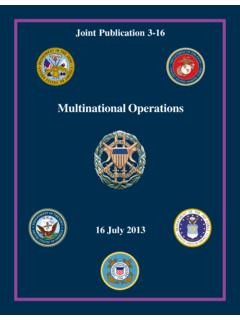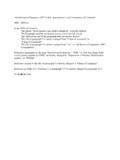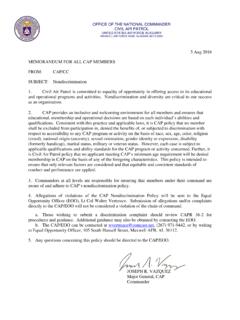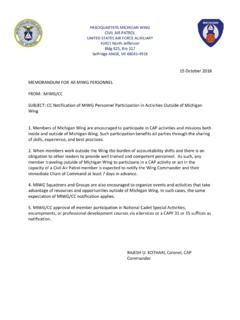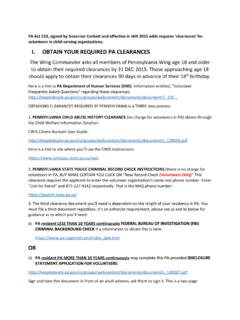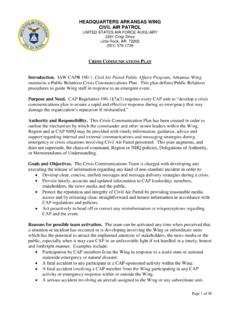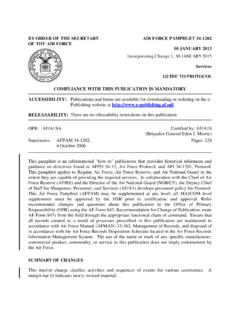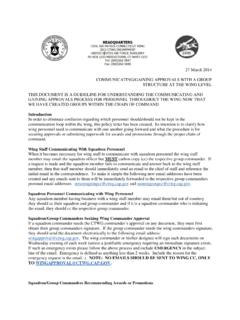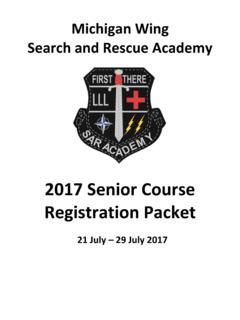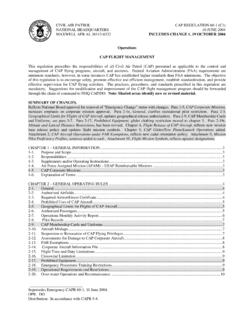Transcription of Chain of Command and Principal Characters
1 Chain of Command and Principal Characters (Radio call signs in italics). Fifth Marine Division Major General Neitzel Division Commander Redfield Twenty-Fourth Regiment Colonel Mulvaney Regimental Commander Bushwhacker First Battalion Major Blakely Lieutenant Colonel Simpson Battalion Operations Officer Battalion Commander Big John Three Big John Bravo Company Second Lieutenant Hawke Staff Sergeant Cassidy First Lieutenant Fitch Executive Officer Company Gunnery Sergeant Company Commander Bravo Five Big John Bravo First Platoon Second Platoon Third Platoon Second Lieutenant Mellas Second Lieutenant Goodwin Second Lieutenant Kendall Platoon Commander Platoon Commander Platoon Commander Bravo One Bravo Two Bravo Three China Second Squad Third Squad First Squad Corporal Fisher (at first) Corporal Jancowitz (at first).
2 Corporal Connolly Lance Corporal Jacobs (later) Lance Corporal Jackson (later). Squad Leader Squad Leader Squad Leader Bravo One One Bravo One Two Bravo One Three Vancouver Hippy Cortell Mole Mallory Parker Pollini Williams Matterhorn, Eiger, and Sky Cap are fictional places; the other locations are real. Matterhorn . Glossary of Weapons, Technical Terms, Slang, and Jargon actual Specific person commanding a unit, as opposed to just the unit in general. For example, if someone calling on the radio said, This is Charlie One, this would mean that it could be anyone on the radio, usually the radio operator, calling from First Platoon of Charlie Com- pany. If the person said, This is Charlie One Actual, it would mean that the speaker was the actual commander of First Platoon. Put your actual on meant I want to talk to your commanding officer.
3 A. J. Squaredaway Marines used made-up names to personify con- ditions or standards. A. J. Squaredaway meant looking sharp. There were others. Joady was the guy screwing your girl back home and Joe Shit the ragpicker was the opposite of A. J. Squaredaway. AK-47 Standard-issue automatic weapon used by the North Vietnam- ese Army and the Vietcong. It fired a bullet at a lower velocity than the M-16. It was much less accurate than the M-16, but far easier to maintain under jungle conditions; and in close-in jungle fighting, accuracy at a distance was not a significant factor. Karl Marlantes Arc Light missions Arc Light was an Air Force operation that used B-52s based on Guam. These B-52s were modified to carry thirty tons of conventional bombs, which were guided to the targets by ground- control radar.
4 The missions were most often flown at night against enemy base camps, troop concentrations, and supply lines. arty Artillery. ARVN Army of the Republic of Vietnam, the South Vietnamese army allies of the United States. ASAP As soon as possible. Avenues A gang of the 1960s in Los Angeles. baseball team Radio brevity code for a squad (thirteen Marines). Basic School, the Lowest-level Marine Corps officer school, where all Marine officers, including Marine pilots, are given the basic educa- tion needed to run a rifle platoon and company. It is located in Quantico, Virginia, and its name is abbreviated TBS. basketball team Radio brevity code for a fire team (four Marines). battalion A battalion, usually about 1,200 to 1,300 Marines and sixty naval medical personnel, had four rifle companies, and one larger head- quarters and supply company (H & S) that held the 106-millimeter recoilless rifles, the 81-millimeter mortars, and the supply, maintenance, communications, mess, medical, and administrative personnel.
5 Each battalion usually had a specific 105-millimeter artillery battery attached to it permanently from the regiment's artillery battalion. A battalion was usually commanded by a lieutenant colonel, often called a light colo- nel. That rank is designated by a silver oak leaf. In the Marine Corps during the 1960s, Command of a battalion was critical for advancement to high rank. battery Artillery unit roughly equivalent in size to a rifle company. A battery in Vietnam had six 105-millimeter howitzers. One battery was normally assigned to one infantry battalion and whenever possible was situated on the highest ground in the area it was intended to support. Matterhorn . The battery often sent out forward observers to move with the infantry to help call in artillery missions. All Marine infantry officers and non- commissioned officers (NCOs) can call in artillery fire; however, lack- ing detailed knowledge of the immense amount of technical difficulties faced by artillerymen, they are usually more impatient than the forward observers.
6 Bingo fuel Out of gas. bird Any helicopter, but for the Marines it was usually a CH-46. helicopter. blowing a dump Destroying an ammunition supply storage site (or ammo dump) by setting off explosive charges in the midst of the ammunition. Brown, H. Rap A 1960s black radical and defense minister of the Black Panther Party. Butterbar A second lieutenant, often new and inexperienced, so called because the rank was designated by a single gold bar. CAG Acronym for combined action group. This was a small group composed of Marines and local militiamen called popular forces (in slang, ruff-puffs, from Republic of Vietnam Popular Forces) that was placed in a small specific area to protect villages from intimidation and terror. This idea achieved considerable success, and the Marines who fought in CAG units were brave and competent, having to operate on their own away from traditional unit structures.
7 Unfortunately, follow- ing the iron law of manipulation that if a system can be invented, a countersystem can be invented Marine infantry commanders would often volunteer shirkers and troublemakers for duty with CAG to get them out of their own units. C-4 Composition C-4 plastic explosive was used for virtually any- thing from cooking coffee to blowing up ammunition dumps and clear- ing landing zones. It came in white bars about one foot long, one inch thick, and three inches across, wrapped in olive drab cellophane. It could be safely dropped, cut, pulled into long cords, or stuffed into cracks. It Karl Marlantes was detonated by blasting caps, which had to be carried in special small wooden boxes and were much more dangerous. When ignited in the open, C-4 burned with an extremely hot white flame but did not ex- plode.
8 Its primary use in this configuration, strictly against policy, was for heating C-ration cans. When detonated by a blasting cap, C-4 was a powerful explosive. A thin cord wrapped around a two-foot-diameter tree would cut the tree in two, although a preferred method was to put one charge slightly higher than another on opposite sides and cut the tree between the two offset blasts. CH-46 Twin-rotor assault helicopter called the Sea Knight, used by the Marines for assaults, resupply, and medevacs. It had a crew of five: pilot, copilot, crew chief, and two aerial machine gunners. It had a long fuselage and a ramp at its tail where Marines got on and off. This ramp was pulled up to serve as the rear door when the CH-46 was airborne. Depending on the altitude, temperature, how many gunners were car- ried aboard, and how much risk the pilot was willing to take, a CH-46.
9 Would carry from eight to fifteen Marines as far as 150 miles. In emer- gencies more people were carried, but then the risks went much greater. Alternatively, the CH-46 could carry about two tons of external load, . slung beneath it in a cargo net. Its maximum speed was approximately 160 miles per hour. The CH-46 Sea Knight was smaller and carried less load than the more familiar CH-47 Chinook used by the Army, although the two helicopters looked similar. Because of the requirement for fold- ing rotors and efficient storage aboard ships, the Marine CH-46 was not capable of carrying the heavier loads that the Army CH-47 helicopter . with its permanent rotor blades and larger engines could manage. The Marine Corps depended primarily on the CH-46 to deliver its units to combat. The CH-46 also doubled as the supply and medevac workhorse because the Marines were insufficiently supplied with the more mo- bile and versatile Huey.
10 CH-47 Twin-rotor turbine-driven helicopter called the Chinook and used by the Army. It was made by Boeing Vertol and from a distance looked like a very large CH-46. Its crew consisted of a pilot, a copilot, a crew chief, and one or two waist machine gunners. The Army chose Matterhorn . the CH-47 as more of a workhorse supply vehicle and depended on the smaller Hueys to deliver its infantry units into combat. chi-comm Hand-thrown antipersonnel fragmentation grenade used by the NVA and Vietcong. It had a wooden throwing handle and a round cylindrical form; hence the nickname potato masher.. chopper Any helicopter. chuck Among Marines in the bush in Vietnam, a non-derogatory term for a white Marine, used by both races, as in He's a chuck dude. It was more along the lines of jive talk, like calling someone a cat.
